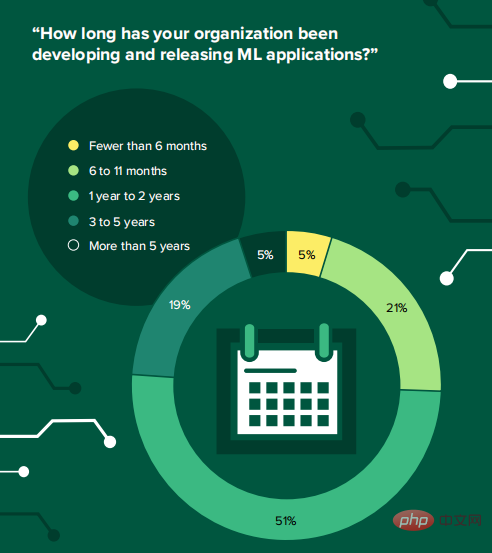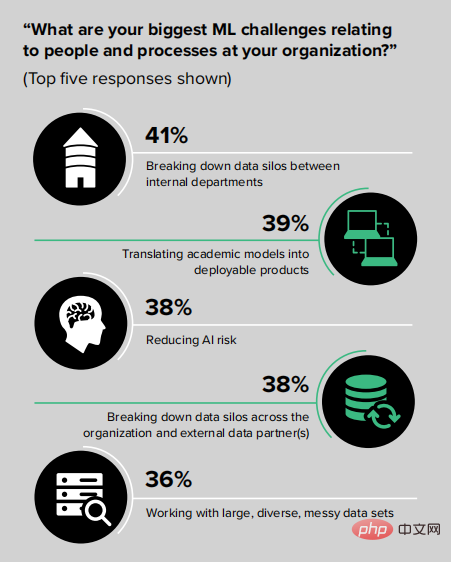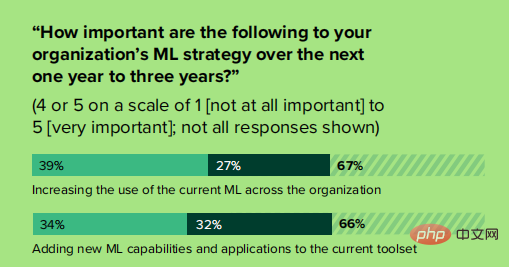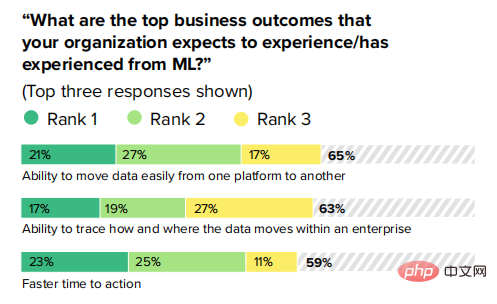Machine learning: 73% of enterprises are lost in survival
Everyone knows that machine learning (ML) is one of the key technologies of artificial intelligence and an application technology that is gradually becoming mature. Specifically, this technology can bring changes to future data science, allowing application companies to make driven decisions based on more data analysis, thereby improving users' business experience.
#So, in what aspects and to what extent has ML improved the business status of enterprises currently? Recently, Forrester Consulting based on a survey of 150 company data leaders and decision-makers in North America, and concluded some important performances of ML in business operation decisions. Which of these survey conclusions can help us and learn from us?
# Let’s first look at some key information.
- In the business affected by machine learning, automated anomaly detection (Anomaly Detection) is the primary task to be achieved in the next one to three years;
- On the technology implementation path, data silos, poor interpretability, and low transparency are the main obstacles hindering progress, thus slowing down the improvement of technology maturity. schedule.
- It would be more beneficial to focus more on business outcomes and to establish partnerships with companies that have a lot of practice and proven effectiveness in ML technology. implementation of this technology.
Only a quarter of ML applications are in the mature stage
In the development and development of machine learning In terms of release time, most respondents chose between 1 and 5 years, accounting for a total of 72%. Among them, more than half said their apps were released in 1 to 2 years. In fact, a mature machine learning strategy requires a precipitation period of three years or more. Only about a quarter of companies that meet this standard have applied it for more than five years, and only 5% of them have applied it.

Additionally, 53% of respondents plan to improve business efficiency by leveraging ML.
In terms of current big data and data analysis strategies, 46% of people choose to use multi-cloud (including private cloud); 44% choose to study stack performance , so as to better utilize data for model architecture; 41% chose to expand the scale to meet the needs of the increasing data volume.
#In the next one to three years, the main strategic application directions of ML are: automatic detection of abnormal data (40%), automatic transparent application Receiving and infrastructure updates (39%), as well as making AI applications comply with new regulatory and ethical requirements (39%), etc.

The most challenging thing to do is to solve data silos in technical management
Except Technical capabilities, machine learning also faces considerable challenges in personnel and process management. Among them, 41% believed that breaking down internal data silos was the most challenging, and 39% chose to convert academic models into deployable products. In addition, 38% chose to reduce AI risks and break down external data silos respectively, and 36% believed that the biggest difficulty lies in processing large-scale, diverse and chaotic data sets.

Whether it is data silos, model transformation, or data set chaos, they all reflect the gap between academia and commercialization. The gap, especially in the transformation of models, is that when using ML and extending it to use cases, many people find that the transparency, traceability, and explainability of the data flow are difficult to clearly present.
Because of this, when the prospect of ML implementation is unclear, management will believe that it is difficult to see business value in business implementation based on machine learning. And if there is no clear relationship with investment return, managers' intention to invest in this technology will significantly decline. 73% of the respondents believe that machine learning still faces challenges in data transparency, traceability and interpretability. The uncertainty of investment intentions has exacerbated the difficulties of technology implementation, and a virtuous cycle has yet to be formed.
Two-thirds of decision makers will still increase the application of ML
However, even in the face of many Challenges, decision-makers are inevitably wary when deciding to invest in machine learning, but most interviewees believe that the application of ML is still very necessary. Two-thirds of decision-makers (67%) believe that increasing the application of ML technology in an all-round way is very important for the organization’s strategic planning. 66% of respondents think it is important to add technical capabilities and applications of machine learning to the currently used toolset.

At the business level, the top three areas where machine learning is expected to play a role include: data platform mutual sharing, enterprise Track data flows within your organization and drive faster action.

As for cooperation with third parties, 37% of the respondents stated that they have established cooperation and intend to develop partners relationship; 30% said they have a cooperative relationship, but are not prepared to develop it into a deeper partnership. In addition, 19% and 11% of the respondents said they have cooperation plans or are interested in cooperation in the next year.
More than 60% of the respondents said that they use cooperative relationships to make up for their shortcomings in machine learning and personnel shortages, indicating that win-win cooperation is still It is an important way to develop this technology. Cooperating with third parties with experience in the field of machine learning can create synergy in model development, personnel training, and mining of more data sources.
Article reference and image source:
##Operationalizing Machine Learning Achieves Key Business Outcomes
The above is the detailed content of Machine learning: 73% of enterprises are lost in survival. For more information, please follow other related articles on the PHP Chinese website!

Hot AI Tools

Undresser.AI Undress
AI-powered app for creating realistic nude photos

AI Clothes Remover
Online AI tool for removing clothes from photos.

Undress AI Tool
Undress images for free

Clothoff.io
AI clothes remover

AI Hentai Generator
Generate AI Hentai for free.

Hot Article

Hot Tools

Notepad++7.3.1
Easy-to-use and free code editor

SublimeText3 Chinese version
Chinese version, very easy to use

Zend Studio 13.0.1
Powerful PHP integrated development environment

Dreamweaver CS6
Visual web development tools

SublimeText3 Mac version
God-level code editing software (SublimeText3)

Hot Topics
 This article will take you to understand SHAP: model explanation for machine learning
Jun 01, 2024 am 10:58 AM
This article will take you to understand SHAP: model explanation for machine learning
Jun 01, 2024 am 10:58 AM
In the fields of machine learning and data science, model interpretability has always been a focus of researchers and practitioners. With the widespread application of complex models such as deep learning and ensemble methods, understanding the model's decision-making process has become particularly important. Explainable AI|XAI helps build trust and confidence in machine learning models by increasing the transparency of the model. Improving model transparency can be achieved through methods such as the widespread use of multiple complex models, as well as the decision-making processes used to explain the models. These methods include feature importance analysis, model prediction interval estimation, local interpretability algorithms, etc. Feature importance analysis can explain the decision-making process of a model by evaluating the degree of influence of the model on the input features. Model prediction interval estimate
 Transparent! An in-depth analysis of the principles of major machine learning models!
Apr 12, 2024 pm 05:55 PM
Transparent! An in-depth analysis of the principles of major machine learning models!
Apr 12, 2024 pm 05:55 PM
In layman’s terms, a machine learning model is a mathematical function that maps input data to a predicted output. More specifically, a machine learning model is a mathematical function that adjusts model parameters by learning from training data to minimize the error between the predicted output and the true label. There are many models in machine learning, such as logistic regression models, decision tree models, support vector machine models, etc. Each model has its applicable data types and problem types. At the same time, there are many commonalities between different models, or there is a hidden path for model evolution. Taking the connectionist perceptron as an example, by increasing the number of hidden layers of the perceptron, we can transform it into a deep neural network. If a kernel function is added to the perceptron, it can be converted into an SVM. this one
 Identify overfitting and underfitting through learning curves
Apr 29, 2024 pm 06:50 PM
Identify overfitting and underfitting through learning curves
Apr 29, 2024 pm 06:50 PM
This article will introduce how to effectively identify overfitting and underfitting in machine learning models through learning curves. Underfitting and overfitting 1. Overfitting If a model is overtrained on the data so that it learns noise from it, then the model is said to be overfitting. An overfitted model learns every example so perfectly that it will misclassify an unseen/new example. For an overfitted model, we will get a perfect/near-perfect training set score and a terrible validation set/test score. Slightly modified: "Cause of overfitting: Use a complex model to solve a simple problem and extract noise from the data. Because a small data set as a training set may not represent the correct representation of all data." 2. Underfitting Heru
 The evolution of artificial intelligence in space exploration and human settlement engineering
Apr 29, 2024 pm 03:25 PM
The evolution of artificial intelligence in space exploration and human settlement engineering
Apr 29, 2024 pm 03:25 PM
In the 1950s, artificial intelligence (AI) was born. That's when researchers discovered that machines could perform human-like tasks, such as thinking. Later, in the 1960s, the U.S. Department of Defense funded artificial intelligence and established laboratories for further development. Researchers are finding applications for artificial intelligence in many areas, such as space exploration and survival in extreme environments. Space exploration is the study of the universe, which covers the entire universe beyond the earth. Space is classified as an extreme environment because its conditions are different from those on Earth. To survive in space, many factors must be considered and precautions must be taken. Scientists and researchers believe that exploring space and understanding the current state of everything can help understand how the universe works and prepare for potential environmental crises
 Implementing Machine Learning Algorithms in C++: Common Challenges and Solutions
Jun 03, 2024 pm 01:25 PM
Implementing Machine Learning Algorithms in C++: Common Challenges and Solutions
Jun 03, 2024 pm 01:25 PM
Common challenges faced by machine learning algorithms in C++ include memory management, multi-threading, performance optimization, and maintainability. Solutions include using smart pointers, modern threading libraries, SIMD instructions and third-party libraries, as well as following coding style guidelines and using automation tools. Practical cases show how to use the Eigen library to implement linear regression algorithms, effectively manage memory and use high-performance matrix operations.
 Explainable AI: Explaining complex AI/ML models
Jun 03, 2024 pm 10:08 PM
Explainable AI: Explaining complex AI/ML models
Jun 03, 2024 pm 10:08 PM
Translator | Reviewed by Li Rui | Chonglou Artificial intelligence (AI) and machine learning (ML) models are becoming increasingly complex today, and the output produced by these models is a black box – unable to be explained to stakeholders. Explainable AI (XAI) aims to solve this problem by enabling stakeholders to understand how these models work, ensuring they understand how these models actually make decisions, and ensuring transparency in AI systems, Trust and accountability to address this issue. This article explores various explainable artificial intelligence (XAI) techniques to illustrate their underlying principles. Several reasons why explainable AI is crucial Trust and transparency: For AI systems to be widely accepted and trusted, users need to understand how decisions are made
 Five schools of machine learning you don't know about
Jun 05, 2024 pm 08:51 PM
Five schools of machine learning you don't know about
Jun 05, 2024 pm 08:51 PM
Machine learning is an important branch of artificial intelligence that gives computers the ability to learn from data and improve their capabilities without being explicitly programmed. Machine learning has a wide range of applications in various fields, from image recognition and natural language processing to recommendation systems and fraud detection, and it is changing the way we live. There are many different methods and theories in the field of machine learning, among which the five most influential methods are called the "Five Schools of Machine Learning". The five major schools are the symbolic school, the connectionist school, the evolutionary school, the Bayesian school and the analogy school. 1. Symbolism, also known as symbolism, emphasizes the use of symbols for logical reasoning and expression of knowledge. This school of thought believes that learning is a process of reverse deduction, through existing
 Is Flash Attention stable? Meta and Harvard found that their model weight deviations fluctuated by orders of magnitude
May 30, 2024 pm 01:24 PM
Is Flash Attention stable? Meta and Harvard found that their model weight deviations fluctuated by orders of magnitude
May 30, 2024 pm 01:24 PM
MetaFAIR teamed up with Harvard to provide a new research framework for optimizing the data bias generated when large-scale machine learning is performed. It is known that the training of large language models often takes months and uses hundreds or even thousands of GPUs. Taking the LLaMA270B model as an example, its training requires a total of 1,720,320 GPU hours. Training large models presents unique systemic challenges due to the scale and complexity of these workloads. Recently, many institutions have reported instability in the training process when training SOTA generative AI models. They usually appear in the form of loss spikes. For example, Google's PaLM model experienced up to 20 loss spikes during the training process. Numerical bias is the root cause of this training inaccuracy,






